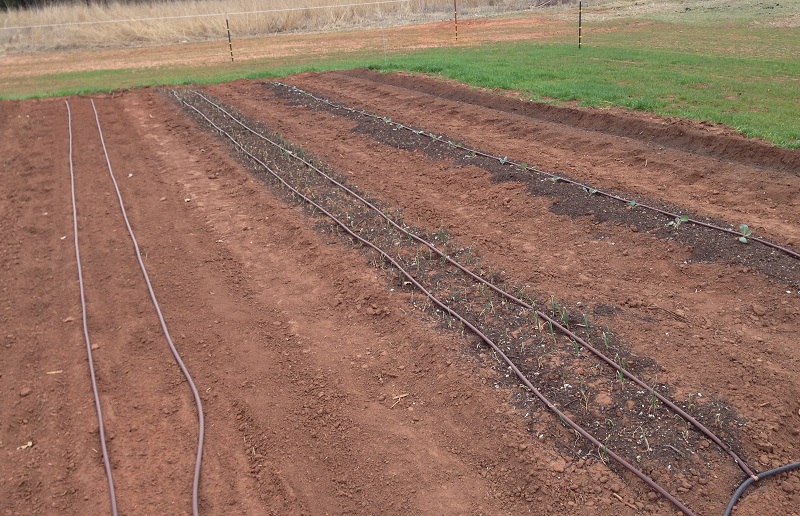From under the elm like a brood wing sheltering (more…)
Author: John
-

Volunteers Help in the Garden
This late spring’s planting season weather has been strange. Frosts in May and the 90 degrees two weeks later. Tomatoes got a very late start with the summer heat approaching. Three of 30 early planted tomatoes have survived. The volunteers don’t mind at all. They come just for the joy of gardening. There is nothing strange about the urge to see things grow and get soil in your hands.
The kind people at Exencial Wealth Advisers have adopted garden! They come once per week to volunteer. In the last two weeks they helped finish planting (90 tomatoes, 100 pepper plants, tomatillos, okra, squash and almost 500 feet of corn!) and mulched.
Weeding and cultivating are the chores they took on this week. The picture above shows D’Anna Boone and Ryan Fuller. D’Anna used her hoe to cultivate potatoes, hilling soil around the plants and clearing weeds. Ryan weeded tomatoes, and I think (in the picture) is noticing the low hanging storm clouds moving our way. Within 15 minutes of that picture, we we swamped in a downpour. We hastily loaded up the buggies and sped for the barn. We were all soaked.
The unpredictable weather continues and our enthusiasm remains strong. A small sign of things to come are ripe strawberries! They are sparse and won’t make a crop, but next year they will.
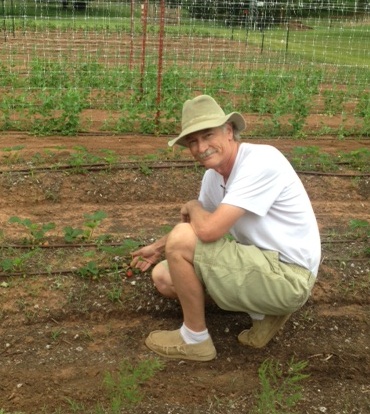
Small as it may be, this is the garden’s first product. The sweet peas in the background will be the first real crop. The trellising has worked perfectly as almost all of the plants have attached to it and are blooming! I wonder if they need side dressing of fertilizer? The peas, onions and potatoes seemed to have disregarded the frosty weather and look pretty good.
Just visible in the foreground are asparagus fronds. The Martha Washington is emerging for the first time.
-
Entropy and Intelligent System Control
A fascinating paper, by Alexander Wissner-Gross, suggests that increasing the entropy of a system, under your control, is an optimal path. This path will preserve most possible future states (and paths) of the system. (more…)
-

Great Blue Herons make nesting colony near the garden
I am lucky to often see these magnificent birds on my pond’s edge stalking fish. They have 6 feet wingspan and long massive beaks on the end of very long necks. They will wade along the shoreline and stab into the water stunning the fish. They then catch the stunned fish and throw it on the bank.
After subduing their prey, they perform a juggling act. They pitch the fish up in the air and catch it head first. This often takes a couple adjustments. As the head of the fish approaches the gullet, the heron stretches their long neck skyward and commences to swallow the fish whole.

Great Blue Heron – Ardea herodias. Notice the long plumage on the head and neck. Here is a good picture from Wikipedia of this beautiful bird. The nests look to be made of large 2-4 foot branches placed at the very top of very large trees. They will raise a clutch of 3-6 eggs.
Adrian dislikes these birds because they feed on the fish in our stocked pond. But I rather enjoy watching these fishermen at work. They are just doing their business. The stocked bass are just now getting too big to swallow. I saw this happen a few days ago.
A murder of crows attracted my attention. They were trying the eat a bass on the bank while a heron, unable to swallow the fish and unable to walk away, halfheartedly tried to fend off the crows. As the heron would saunter away from the bass, the crows would hop near the bass and peck at it. The jealous heron, seeing this, would come back and try to pick up the fish. Unable to gulp down the fish, the heron would walk away giving leave to the crows.
I lost interest in the scene before its conclusion. It seemed obvious that the crows, endowed with the virtue of patience, would win this meal.
These birds are very shy. They fly at the first sign of humans. I am concerned that they are very close to the garden (100 yards or more) and that we will spook the birds from their rookery. We will keep the tractor clear of the garden as best we can over the next few weeks. Hopefully our work will not disrupt their business. I am more than happy to share fish for the enterprise. Especially now that sunfish have become their most likely edible prey.
From one fisherman to another: Good luck!
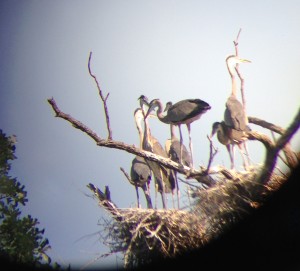
Seven chicks! Update – 6/18/2014 – The Herons returned this year and I got a picture of some chicks in the nests.
-

April’s Fool
Oh boy have I been wrong about the weather. Blog after blog, I’ve forecast an early spring. We planted tomatoes, now dead in the garden, in late March. The weather has made a fool of me. Even cold tolerant cabbage froze when the temp reached 20 F and was replanted.
Oh and the drought I’ve planned for is another surprise. Most of late winter the garden needed water to even work the soil. There had been no heavy rain since leveling and tilling the garden in August. But now we have had several very nice days of rain. Last week we had 5 inches slow soaking rain. Every 10 day forecast seems to show a couple days of rain. The garden is often too wet to work. My over-engineered irrigation system makes me feel a bit foolish too.
We are keeping all of the seedlings of tomato and tomatillo outside during the day and return them to the hot house over night. Both are getting too big for the pots they are planted. Ugh – the grafted tomatoes look completely root-bound and are falling over. They needed to be planted 2 weeks ago, but must wait until this late frost passes.
I don’t know why confessing foolishness is important. A good confession cleans the soul. But even a public confession will probably not correct my behavior. It is just too much fun to try to predict how the world will unfold. Maybe I should post a warning to blog readers or waive liability of any and all utterances made or implied on this site.
-

Tomatoes are planted, let the gardening season begin!
Planting onions and potatoes is not as satisfying as planting tomatoes. This planting starts the gardening season for me. Maybe this is because my earlier gardens were small and very few varieties could be put in, so tomatoes, my favorite veggie to grow, was usually first.
This year the first tomatoes in are Celebrity and Big Beef seedlings which were started early. Planting early is risky but these plants may well produce the first fruits of the season. Does everyone want to say: “I am already getting tomatoes from my garden!”? I need to shake off this boast and replace it with: “Man we are harvesting lots of tomatoes!” If is true then our food bank clients will be very happy.
The seedlings are long and lanky, perfect for planting ‘on their side’. Long seedlings are laid in a trench, about 6 inches deep, so that the stem is mostly underground. The tip of the plant is gently bent to point up and out of the trench. Only a few leaves at the tip of the plant peek out above ground. In about two weeks the entire buried stem becomes covered with roots establishing a great root base for the plant. Half the roots will come from the root ball and half from the stem. We plant the stems to align with our drip irrigation lines so the roots are nearest water and cultivation near the row will not disturb major roots.
The soil 1 foot below ground was very compact. It was difficult to drive a stake or to spade up. To encourage roots to grow down, the ground was broken with a 2 foot breaking plow. Each bed was plowed twice with this breaking plow. It is also called a sub-soiler. Tomato roots can be 5 feet long. To get this long they will need to grow down.
It is risky to plant tomatoes in March in Oklahoma. Historical last frost is March 4th. But this is long history. A shorter view of ‘history’ is our heat wave. The last few summers have been ‘historically’ hot. Last year the last frost was March 7th. The heat has reduced the number of days tomatoes set fruit. So these early risky tomatoes hedge against another hot year. These tomatoes will have had a couple more weeks to bloom than later plantings (early April).
The seasonal changes in Oklahoma make it a great place to live. If you like to see this sort of thing. In an Oklahoma spring, pears and plums bloom first, large flocks of Cedar Waxwings fly together whistling and take water at my pond. Daffodils and chickweed are in full bloom too. Wild geese pair up. But despite all these signs and having peas emerging by the hundreds, and 1/2 the garden already in the ground, planting the tomatoes marks the beginning of the garden season for me.
-

The Garden is Greening
You have to look very closely. It is not obvious. The garden is greening! Plums and Pears are blooming! Spring is in two days, snow is in the 4 day forecast, yet plants are emerging and greening up the garden. If you look closely above, the few herbs and garlic look strong. The onions are beginning to set roots. I expect the peas to come up any minute!
Notice the drip lines are installed, and this 1/4 of the garden is planted. Adrian did the heavy lifting and dug 100 feet of 18 inch deep trench to plant asparagus. We filled 1/3 of the trenches with chicken litter compost and planted Mary Washington and Jersey Knight. The herbs provide instant green. Planted Rosemary, Oregano and Sage. The Chives from seed should go in tomorrow.
The following show a 4 row section of cabbage onion, carrots and potatoes. It is quite a mix of veggies side by side. Crop rotation in the garden is going to be difficult. We have so many peppers, tomato, and potato: these make up over 1/4 of the garden. Each is in the same family and rows should not have any of these for 3-4 years. Will have to be clever with rotation.
The grass we planted in October is doing well. It is the greenest success so far. The deer keep it mowed outside the fence and inside almost needs mowing now. The grass mix is annual rye, perennial rye and white clover. The clover sprouted last winter but is scant.
Still planning on getting in some early tomatoes next week (if no snow or freeze in 7 day forecast).
-

Tomato fruit set temperature
The 2012 tomato season was poor for most people. I even heard about an elderly couple quitting gardening because of very low yield last year, saying, “It is just not worth all the work!” I think last year’s trouble was high temperatures.
Tomatoes, America’s favorite garden veggie, were hit especially hard. They require certain temperature ranges to set fruit. Night time, when the fruit is set, must be between 62 – 70 degrees F. Normally night temps fall into this range frequently and tomato blooms set fruit. But last summer, in June, night temperatures rose above 70 F and stayed there until August 10th. Below you can see that 2009 had days throughout the summer.
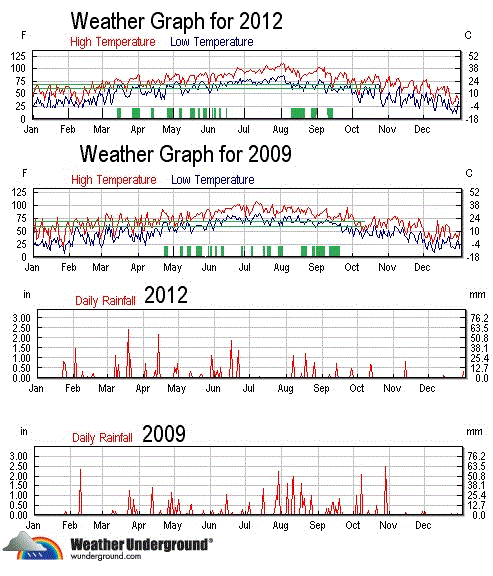
Green bars are days when night temps between 60-70 F. In 2009 the last spring freeze was about April 7. But in 2012 the last freeze was March 7. Last year I luckily planted tomatoes early and the plants set fruit in April. But if you planted late, you might only get a few fruit clusters to set before the summer heat began.
I have to admit to “irrational exuberance” each spring. Spring fever is very strong. Today will be 80 F. I want to plant early.But based on the charts and a generally warming climate, a little risk may reward with a better crop of tomatoes. Or am I simply feverish?
Either way, I have started enough tomato plants to risk a few. In my own little garden I have covered early plants with success. Covering them with plastic has protected them from light frost. Elm Tree Garden is bigger and would be more work to protect the plants.
I think I will start 50 feet of tomatoes next week and hope for the best. I have planned this with some Celebrity and Big Beef seedlings which are being hardened off for that last several days. They are ready. I also planned on enough seedlings to replace these plants if frozen.
Here the “Average” last frost date is April 1. But climate warming is happening and may have pushed the future last frost dates into March. I believe it has. Plant some of your tomatoes early in you are in Oklahoma and spread your risk.
-
Plant list update
This is the latest plant list for 2013. Several plants will be replaced after an early harvest and a second planting of anther variety will follow. The picture below exaggerates harvest time of these early crops like peas and scallions. Pole beans will follow peas and squash will follow the scallions and sweet onions.
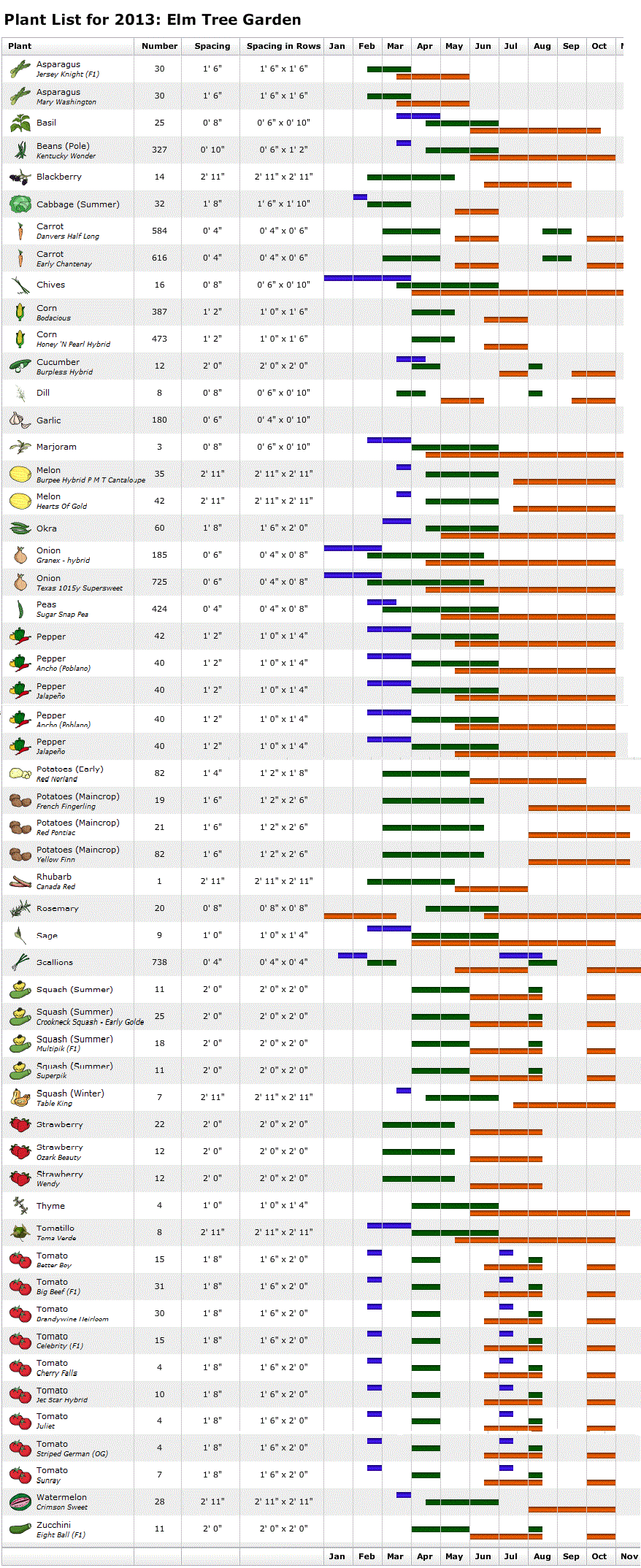
Elm Tree Garden 2013 plant list. -

Tomato Grafting: after 7 days
The tomato grafting project is working. As you can see the result in these pictures. I waited too long to do the grafting and much of the scion (top) seedlings were to big to fit into the grafting clips. Next year I will be ready.
Some of the grafts wilted and are dead. But less than 1/4 of the plants wilted. The German Striped are strong looking despite having poor grafting union. See the bottom right of the following picture. These are German Stripe. The rest are Brandywine.
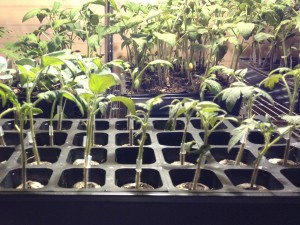
Brandywine and German Stripe tomatoes grafted with Colosus root stock. Click to enlarge. I hope to have enough Brandywine to do a good A/B test. I will plant 2 half rows (25 ft). Half of regular Brandywine (A) and half of grafted plants (B) will be planted in these side by side rows. Each 1/2 row will have 15 plants. I hope to have a few for my smaller garden too. There I will do a smaller similar test on the German Stripes.
In the background of this picture are the (A) tomato seedlings. They will have a big head start. Notice they are twice as tall as the grafts. I will also be able to plant the (A) seedlings on their side, burying most of the stems with just a few leaves above the soil. This helps the plant produce roots along the buried stem.
The grafted seedlings (B) must be planted with the graft above the ground so that all the roots are Colosus roots. But this will not be as effective as planting it on its side. I hope this does not skew my test.
Unless there is a frost in the 10 day forecast, these tomatoes will be planted in 2 weeks or about April 1st.


